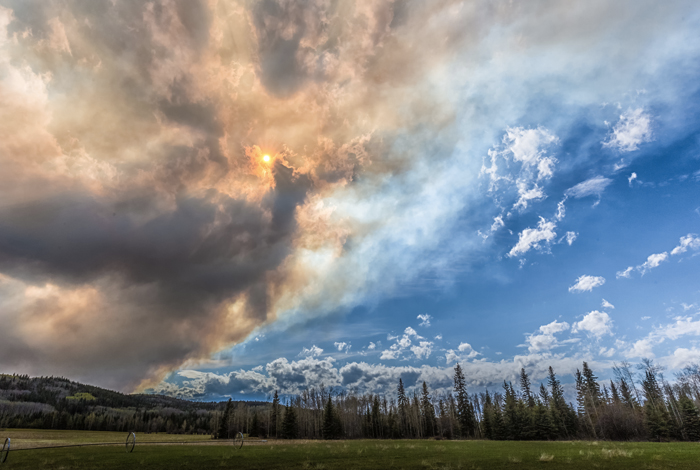Jul 13 2020
A new study shows that the impact of tiny, sunlight-absorbing particles found in wildfire smoke on climate may be less than considered. This is because reactions that occur when the plume mixes with clean air decrease its absorbing power and thus its climate-warming effect.
 Los Alamos research reveals that wildfire smoke plumes contribute less to warming temperatures than previously thought. Image Credit: Dreamstime.
Los Alamos research reveals that wildfire smoke plumes contribute less to warming temperatures than previously thought. Image Credit: Dreamstime.
As part of an exclusive megafire study, a team of researchers led by Los Alamos National Laboratory investigated the properties of smoke that emanated from Arizona’s massive Woodbury Fire last summer. They used a robust set of observation techniques for their study.
These observations may be useful for those trying to represent organic light absorbing aerosols, or brown carbon, in climate models by identifying how they age, as well as understanding processes affecting how strongly they absorb light and cause warming.
James Lee, Postdoctoral Researcher, Los Alamos National Laboratory
Lee is the lead author of a paper recently published in JGR: Atmospheres.
Before the Woodbury Fire could be contained, it burned almost 124,000 acres for more than a month. Researchers from Los Alamos and New Mexico Tech used robust instruments, such as an aerosol mass spectrometer at Los Alamos’ Center for Aerosol Forensic Experiments (CAFÉ), to measure the physical, chemical, and optical properties of ambient trace gas and aerosol concentrations in four large plumes in real time.
The composition of the plumes and the aerosol properties within the plumes were found to be are more varied than predicted. When smoke is oxidized more, its sunlight-absorbing potential decreases, thereby reducing its climatic impact.
Wildfire plumes are complex and change quickly. Particles at the plume’s center have different shapes and chemistries than at its edge.
Allison Aiken, Study Coauthor and Atmospheric Chemist, Los Alamos National Laboratory
The researchers could observe more disperse and intact plumes aging over half a day while traveling 300 miles across New Mexico. This led to retaining of comparatively unchanged aerosols at the core of the plume, while offers a valuable understanding about how the smoke transforms upon mixing with cleaner air.
This is important as we need to capture the physicochemical changes that occur as plumes are transported long distances to model the climate impacts correctly and to understand the human health impacts at different locations and distances from the source.
Allison Aiken, Study Coauthor and Atmospheric Chemist, Los Alamos National Laboratory
The researchers found that emissions from the Woodbury fire included brown carbon that absorbed light at a potency that confirmed earlier observations. However, this was true only in the core of the plumes. By contrast, at the edges, far less light was absorbed by the organic aerosols.
From fine-scale results, it was found that mixing and oxidation made the brown carbon lighter, thereby decreasing its potential to absorb light and cause warming. This shows that the warming effects of brown carbon from wildfire are smaller than established model assessments.
The research group included Lee, Aiken, Petr Chylek, and Manvendra Dubey from Los Alamos and Kip Carrico from New Mexico Tech in Socorro, N.M.
Funding
This study was financially supported by the Office of Science of the U.S. Department of Energy (DOE), Office of Biological and Environmental Research (BER), Atmospheric System Research (ASR) Program, and Office of Workforce Development for Teachers and Scientists.
Further support was provided by the National Science Foundation, the Los Alamos Laboratory Directed Research and Development program, and the New Mexico Consortium.
Journal Reference:
Lee, J. E., et al. (2020) Optical and chemical analysis of absorption enhancement by mixed carbonaceous aerosols in the 2019 Woodbury, AZ fire plume. JGR: Atmospheres. doi.org/10.1029/2020JD032399.